When someone recommended The Essence of Perfume by one of the world’s most respected perfumers, Roja Dove, I quickly placed an order on Amazon. I had no idea I’d soon be receiving such a beautiful, lavishly illustrated volume. Like most of us I do most of my reading on my iPad; even my magazines I peruse through the Texture app, but I also adore my hardcover coffee table books.
The Essence of Perfume is probably the most gorgeous book I own. A truly prized possession. I would’ve happily paid twice or even three times the price for a book of this quality. Weighing in at over four pounds it’s undoubtedly the heaviest too.
Printed on heavy paper and filled with lavish illustrations and glorious photos, it speaks to both beginners to the world of fragrance as well as die hard fragrance enthusiasts like myself. The Essence of Perfume contains lots of wonderful bits of information about a variety of topics. This is not an in-depth book about how perfume is made and how it works on our sense of smell; it’s more of a “sampler” about fragrance.
Most perfume books that I’ve come across are too scholarly to the point of being almost boring or they’re interesting reading but lacking in visual presentation.
This one contains a wealth of information in eye candy format. Many of the beautiful and rare images are from the author’s private collection.
The book opens with an explanation of scent and describes the various methods by which perfume notes are extracted. It then goes on to show the various raw materials used in the process (all graphically illustrated) and explains the key aspects of perfumery.
My favorite parts were the history of perfume, starting from the birth of modern perfumery up until today, and the great modern classics.
Dove describes the impact of significant world events and how they helped define each decade in terms of social norms and attitudes. He describes how these events also helped to define fashion and fragrance starting from the 1910s through the 1990s.
Here’s a blast from the past:
The 1910s:
In the 1910s, perfume, like the decade’s women, was emancipated. The Russian Revolution, the First World War and the sinking of the unsinkable Titanic brought immense change. The role of women changed dramatically too. Couturier Paul Poiret did away with the corset, the bustle and the bustier; Gabrielle Chanel created dresses out of jersey and Edwardian hair was replaced with the bob.
With everything being rewritten, this decade saw the emergence of the Chypre accord in perfumery. Significant perfumes of the decade include: Narcisse Noir by Caron, L’Heure Bleue by Guerlain, Quelques Fleurs by Houbigant, Chypre by Coty, Tabac Blond by Caron and Mitsouko by Guerlain.
The 1920s:
In this decade, Alexander Fleming discovered penicillin and the tomb of Tutankhamen was opened. It was also a time when women really started to redefine themselves. The new style of clothing was much easier to look after and helped to liberate women from the laundry room. Cinema introduced a new type of woman, the modern American. The enormous slaughter of young men during the First World War brought about feelings of futility and mass sorrow, resulting in a craving for newness and youth. After the war ended, men expected everything to return to normal but women refused. Marie Stopes began a program of education to inform women about the benefits of contraception and for the first time women became aware that they had access to contraception and more control over their own bodies than ever before.
In America, women won the right to vote and the Women’s Temperance League helped establish prohibition. Jazz became an overnight sensation in the music world and the opening of nightclubs and cabaret lounges unleashed a new hedonism. The television was invented.
Noteworthy perfumes: No.5 by Chanel, Nuit De Noel by Caron, Shalimar by Guerlain, Arpege by Lanvin, and Joy by Jean Patou.
The 1930s:
After the hedonistic, crazy 1920s, the 1930s seemed relatively calmer. Sadly the calm didn’t last long.The scandal of the decade was when King Edward VIII renounced his throne to marry an American divorcee named Wallis Simpson. Traditionalists were disappointed he would give up his duty for a woman like Wallis Simpson while some saw it in a more romantic light that he would give up his throne for the woman he loved.
Hemlines were lowered to a new position below the calf and the hair went up.
Times were tough for the average person, and the cinema provided a form of escapism. Every film seemed to conclude with a happy ending, despite harsh real-life realities. The depression in America brought hardship and turmoil not only to the poor, but also to many who had been well-to-do before the Wall Street crash of 1929. People were fighting for survival in England too, and the decade was characterized by hunger marches and general despair.
The super-rich carried on as usual, taking holidays on the Cote d’Azur, and flocking to Berlin, which had become the hedonistic pleasure capital of Europe. The divide between rich and poor was greater than ever. Idealists started seeing communism as a way out and a solution to the problems of the West.
Hitler came into power in Germany, capitalizing on the economic problems and the punitive peace agreed after the First World War. There were dark clouds on the prospect of international peace.
As often happens in perfumery during times of economic hardship, the Oriental family was the most prevalent style. The vanillic notes provided a form of escape from the reality of day-to-day life.
Noteworthy perfumes released included: Tabu by Dana, Je Reviens by Worth, Vol De Nuit by Guerlain and Shocking by Schiaparelli.
The 1940s:
The impact of the war caused huge shortages of what had been previously thought of as everyday items, such as food and clothing. As people went off to the battlefields or were lost in concentration camps, most creativity was brought to a halt. Class barriers gave way to patriotism, which was to remain for many years after the war.
American culture had impacted Europe mostly through the popularity of cinema, but now people came into contact with GIs. The bond between Britain and America became stronger, and so did each country’s reliance on women to protect and nurture their homeland.
The end of the Second World War created a desire to make a world fit for heroes, one better aided by new technology and mass-production. Social needs had to be addressed since war was expensive and everyone felt the need to tighten their belt.
There arose a craving for newness and a desire to create a brave new world. Bebop and jazz replaced the Waltz and the Vespa came to be known as the symbol of youth in Italy.
In perfumery, the world’s desire for change arrived in the so-called “green” note. Freshness was an important theme, especially for the millions of refugees trying to establish themselves in Germany. There was a huge black market for nylon stockings, cigarettes and coffee.
There was a mass of creativity immediately following the war, built around a common theme of liberty and change. Significant perfumes of the decade include: Bandit by Robert Piguet, Femme by Rochas, Ma Griffe by Carven, Le Dix by Balenciaga, Vent Vert by Balmain, Miss Dior by Christian Dior, L’Air Du Temps by Nina Ricci and Fracas by Robert Piguet.
The 1950s
The 1950s was a decade of rock ‘n roll, blue jeans and youth culture. Two celebrities who really helped define it were Marilyn Monroe and Elvis Presley, who influenced notions of desirability throughout not just America but the world over.
Blurring boundaries between public and private life as well as celebrity became a common phenomenon that shaped the social fabric. The coronation of Queen Elizabeth II was filmed and televised to the nation. A new type of royalty was being aspired to as well. The jet-set royalty of Princess Margaret and the private life of the Shah of Persia and his wife attracted international attention.
Fashion was also becoming fractionalized, with high fashion lines such Dior and Balenciago one the hand and the blue jeans craze of the youth on the other. Fragrance was also changing, with the freshness on the 1940s being replaced by more animalic and aggressive accents.
American fragrance houses Estee Lauder and Revlon, who had been making perfumes for a while already, played a major role in making fragrance more glamorous on an international level.
The concept of the American dream also firmly took hold: getting married, having children and creating a “perfect” home, as shown in the advertisements featuring Doris Day. Marriage, like diamonds, was forever and while women were permitted to have a “small” job outside the home, they only perceived as successful if they were perfect homemakers, glamorously made up and coiffed while doing their cooking and cleaning.
The Cold War and the nuclear arms race were both at their heights. Certain that there was a Communist threat, Americans became more inward-thinking. The matriarchal nest-builder and loving housewife no longer existed just in the minds of the advertising agencies, she now came to epitomize all that was good in the world.
Important perfumes of the decade include: Youth Dew by Estee Lauder, Diorissimo by Christian Dior and Cabochard by Gres.
The 1960s:
The 1960s was a time of more unprecedented change. Man landed on the moon and the pill allowed women even more control over their bodies. Anything and everything seemed possible. Youth and liberation were the driving forces that changed world order during this decade.
Sex was big on everyone’s agenda and social taboos were being openly challenged. Abortion was legalized in Britain in 1967 and America followed suit three years later. London became the epitome of the “swinging 60s” and Liverpool produced the “yeah, yeah, yeah” singing Beattles, with their long hair-cuts and shiny mohair suits. The mini-skirt was invented, worn by a waif-thin young girl who’s face came to symbolize the decade – Twiggy.
In America, Woodstock was to become synonymous with another important movement, one which rejected materialism – the hippie movement. They turned to nature, hugged trees as well as each other and went on psychedelic trips. “Turn on, tune in, drop out” became the mantra popularized by Timothy Leary, who led the West coast gathering of 30,ooo hippies at the Be-In at golden Gate Park in San Francisco.
Hippies protested against the war in Vietnam and everything the establishment stood for. In a quest for their own Nirvana, they turned to the East and embraced meditation, incense, patchouli, musk and rose. These became important materials used in perfume during this decade and many classical themes were reworked to include them.
The entire world seemed to embrace the concept of freedom with America passing the Civil Rights Bill and homosexuality was legalized in Britain. It also became the decade of protest marches which began peacefully but ended with violent confrontation, such as the student riots of 1968. Women were becoming more political and held their own revolts about obtaining equal rights.
In America, President Kennedy and his wife Jaqueline signaled a breath of fresh air and suggested that hope, fairness and equality for all were possibilities. This sense of hope was shaken to the core when Kennedy was assassinated, and later multiplied by the murder of Martin Luther King.
Music and art pushed the boundaries and pre-empted change. Andy Warhol changed perceptions of what could be called “art” with his images of tins of soup.
Perfumery changed too, especially after Estee Lauder gave us Estee, the “superscent”, which contained an unrivaled amount of staying power and volume. Newly developed musk served to not only increase odor but also had the effect of slowing down evaporation. Consumers now began demanding scents that lasted.
Significant perfumes were: Madame Rochas by Rochas, Caleche by Hermes, Fidji by Guy Laroche, Chamade by Guerlain and Calandra by Paco Rabanne.
The 1970s:
This was a decade of bifurcation; there were groups of thinking and each group believed that they were right and rejected the beliefs of other groups. Students had stopped rebelling and were focused on starting their careers. There was a rise in consumerism and anti-authoritarian day-care centers for children. Lesbians wanted nothing to do with their mothers, youth wanted nothing to do with the elderly and mother-earth types rejected the cosmopolitans.
Fashion began falling into certain “looks” which reflected one’s political views. At the start of the decade everyone loved disco and the general mood was one of optimism, but as the first energy crisis hit in 1973 it signaled the beginning of a shaky political scene which only continued to get worse. The revolution in Iran, civil war in Pakistan, the seemingly never-ending war in Vietnam, the doomed Apollo 16 mission and then Watergate. The feeling of optimism was replaced by cynicism.
People started to feel the need to question and examine everything. Along with this desire to look behind the facade came experimentation: platform shoes, boob-tubes, glam rock and hot pants seized the moment. Anything and everything went.
At the same time, a major movement, that of feminism, was taking hold and gathering steam. While the 1950s American dream still existed, feminists were actively campaigning against it. This was also the decade that Margaret Thatcher became the first female British Prime Minister and babies could be created in test tubes.
The 1970s also brought about one of the most significant changes ever in perfumery. The world’s first “lifestyle” scent – Charlie – was launched by Revlon. This also became the decade of “green” notes, semi-orientals and Tea Rose. If fragrance houses wanted to survive they needed to keep up with the changes.
Perfumes of the decade included: No.19 by Chanel, Diorella by Christian Dior, Alliage by Estee Lauder, Charlie by Revlon, Coriandre by Jean Couturier, Chloe by Chloe, First by Van Cleef & Arpels, Opium by Yves Saint Laurent, Oscar by Oscar de la Renta, Lauren by Ralph Lauren, Anais Anais by Cacharel and Nahema by Guerlain.
The 1980s:
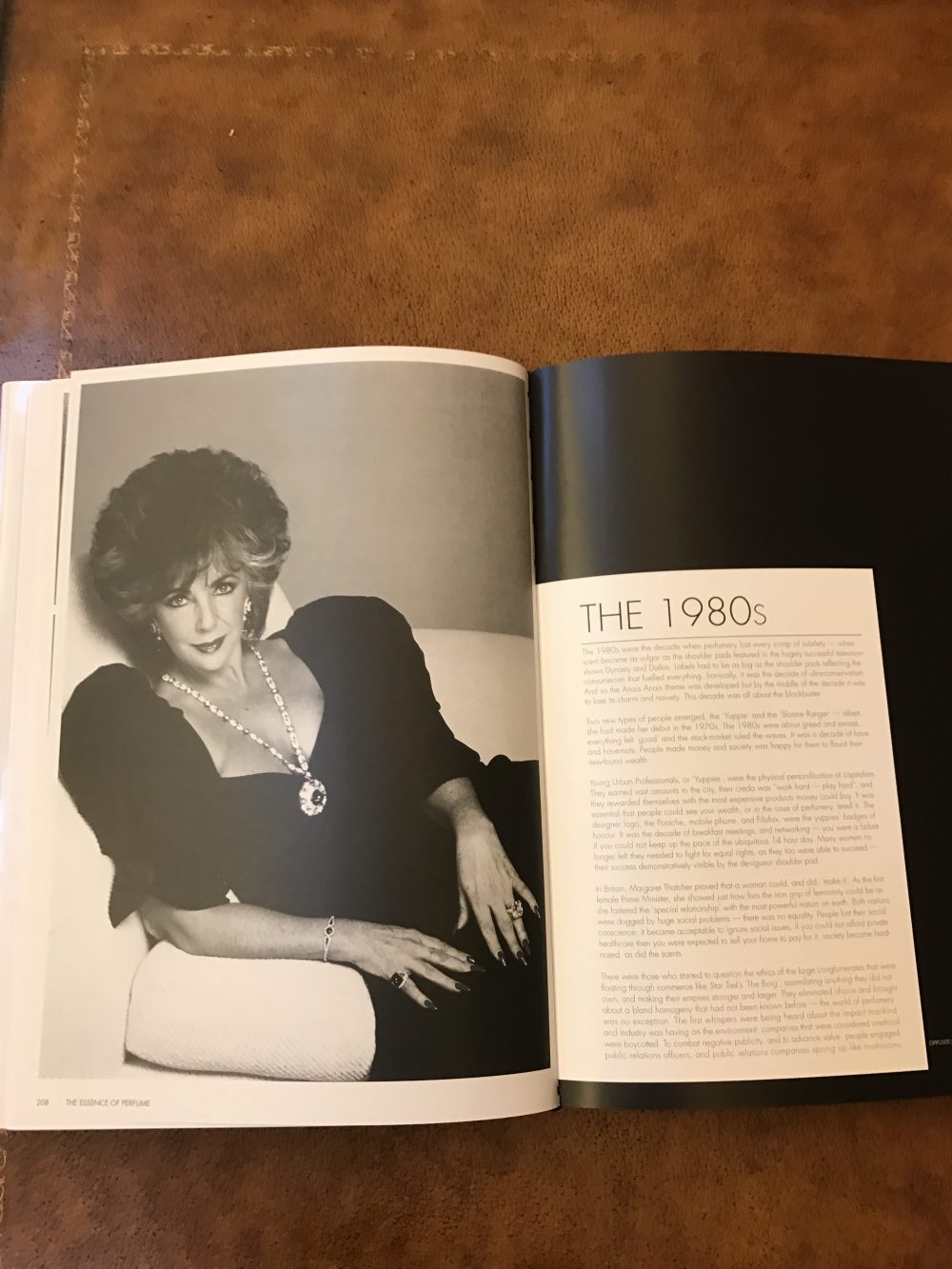 The 1980s came to be known as the decade when perfumery lost every last bit of subtlety. Fragrance became as vulgar and overdone as the huge shoulder pads shown on popular TV shows like Dynasty and Dallas.
The 1980s came to be known as the decade when perfumery lost every last bit of subtlety. Fragrance became as vulgar and overdone as the huge shoulder pads shown on popular TV shows like Dynasty and Dallas.
Consumerism fueled everything and everything had to be a blockbuster. Two new types of people prevailed: the “Yuppie” and the “Sloane Ranger”. The 1980s were a time of greed and excess, led by Wall Street, and people were happy to flaunt their new-found wealth. It was also a time of have and have-nots.
Young Urban Professionals, or “Yuppies”, were the ultimate personification of capitalism at work. Their modus operandi was “work hard, play hard”, and at the end of the day reward themselves with the most expensive products money could buy. It was critical that others could see their wealth or, in the case of perfume, smell it.
It was the decade of 14-hour day, the breakfast meetings and constant networking. Many women no longer felt that they needed to fight for equal rights since they were now able to succeed, and the shoulder pads became their new badge of honor.
In Britain, Margaret Thatcher proved that it was possible for a woman to “make it”. But both countries were plagued by huge social problems and there was no equality. Many lost their social conscience and it became acceptable to ignore social issues. If someone couldn’t afford private health insurance, they were expected to sell their home to pay for it.
As society became more hard-nosed, the perfumes of the decade reflected this.
As the Berlin Wall came crashing down, the “communists” were able to enter the Garden of Eden that was consumerism. However, the bubble finally burst at the end of the decade and the world was thrown into recession. This came as a rude awakening to some who saw their financial lives shatter overnight. And to add to this nasty shock, a terrible disease took center change. HIV and AIDS became all that anyone could talk about. Safe sex became the new way of life and it almost seemed like payback time for all the fast-living.
Noteworthy perfumes of the decade included: Must de Cartier by Cartier, Giorgio by Giorgio Beverly Hills, Ombre Rose by Jean-Charles Brosseau, Paris by Yves Saint Laurent, Poison by Christian Dior, Calyx by Prescriptives, Montana Parfum de Peau by Claude Montana and Samsara by Guerlain.
The 1990s:
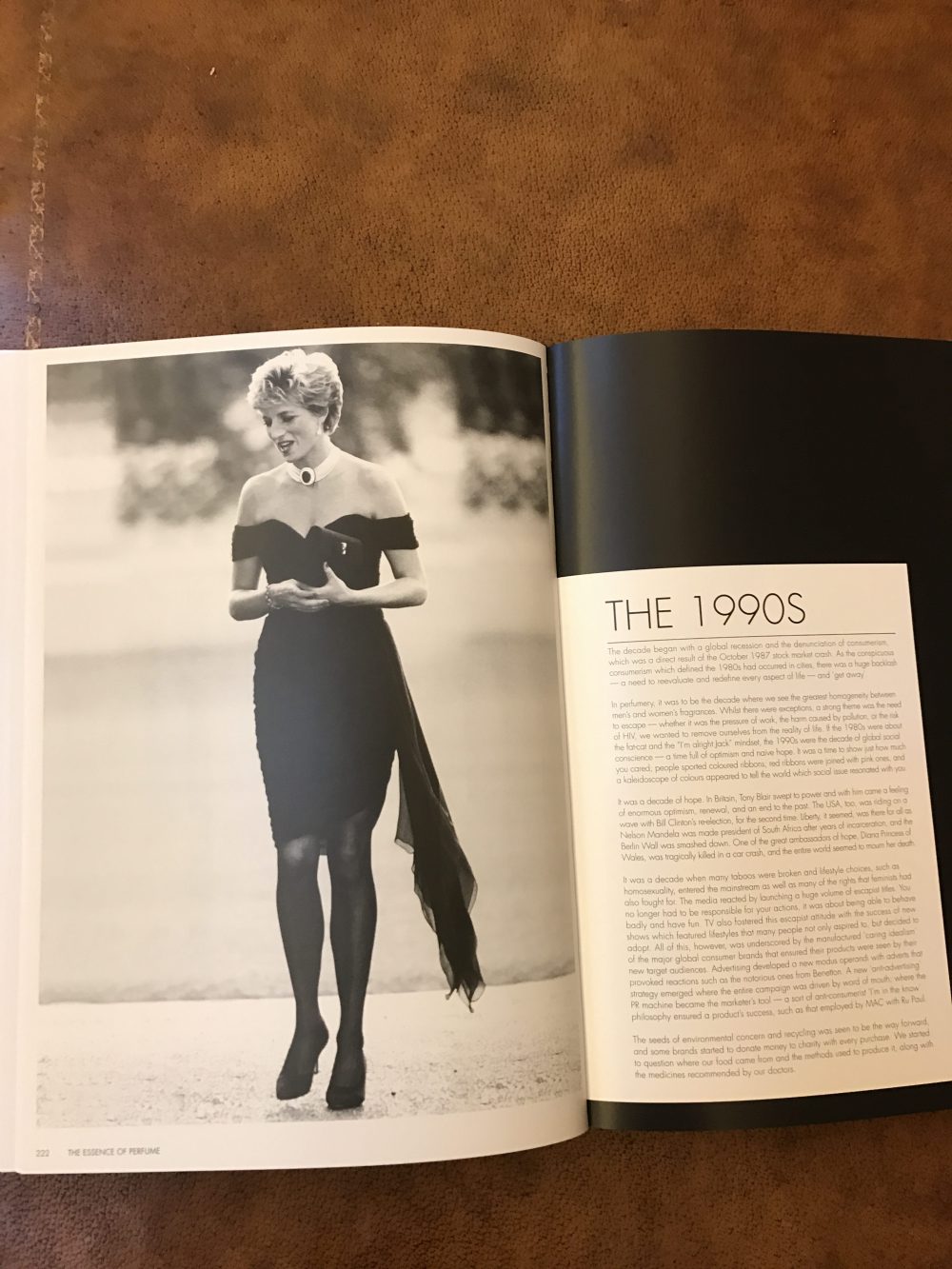 The 1990s started out with a global recession and the rejection of consumerism, which resulted from the October 1987 stock market crash. Most of the former conspicuous consumption of the 1980s took place in the cities and this decade produced a desire to reevaluate every aspect of one’s life. In some cases this produced a desire to “get away” and “escape”.
The 1990s started out with a global recession and the rejection of consumerism, which resulted from the October 1987 stock market crash. Most of the former conspicuous consumption of the 1980s took place in the cities and this decade produced a desire to reevaluate every aspect of one’s life. In some cases this produced a desire to “get away” and “escape”.
In perfume, this was a decade of greater homogeneity between men’s and women’s fragrances than ever before. A strong theme was the need to escape – whether it be from the pressure of work, the harm caused by pollution, or the risk of HIV, people wanted to remove themselves from the realities of life. This was a decade of global social conscience and to people chose social issues that most resonated with them.
A sense of optimism and hope had returned. In Britain, Tony Blair came to power and with him came a feeling of hopefulness and renewal, Nelson Mandela was made president of South Africa after being incarcerated for many years and the Berlin Wall had come down at the very end of the previous decade.
One event that dampened that hope though, and certainly left its mark on the decade, was the tragic death of Diana Princess of Wales who was killed in a car crash. The entire world united in mourning the loss of one of our great ambassadors of hope.
The 1990s were also a decade when many taboos were broken and lifestyle choices like homosexuality became mainstream.
Major global consumer brands adopted a “caring idealism” approach in the marketing of their products and new advertising campaigns, such as the notorious Ebony and Ivory one from Benetton, were designed to provoke reactions. Environmental concerns and recycling took on a greater importance and certain brands began donating money to charity with every purchase. People started questioning where their food came from as well as the method used to produce it. They became interested in learning more about the medicines recommended by their doctors before taking them.
The decade came to a close right before the start of the new millennium. The hype was so great about how to celebrate this momentous occasion and prices became so exorbitant, that many decided to spend it in a low-key way with family and friends, reflecting and speculating on what would happen next.
Prominent perfumes of this decade included: New West for Her by Aramis, Tresor by Lance, Amarige by Givenchy, Escape by Calvin Klein, Casmir by Chopard, Angel by Thierry Mugler, Eau Parfumee au the Vert by Bvlgari, Feminite Du Bois by Shiseido, Ambre Sultan by Serge Lutens, CK1 by Calvin Klein and Happy by Clinque.
The Essence of Perfume concludes with Roja Dove offering his thoughts on “What’s Next” in perfumery. He ends with a poignant story that is heartbreaking. He closes with, “The moral of this story is: be very careful about which scent you choose, as it can have devastating effects on those around you. I hope this book helps you appreciate the scents you wear and those you are yet to discover.”
I really can’t recommend this book more highly. If you should decide to buy it, I’d love to hear your thoughts:)
Until the next time,
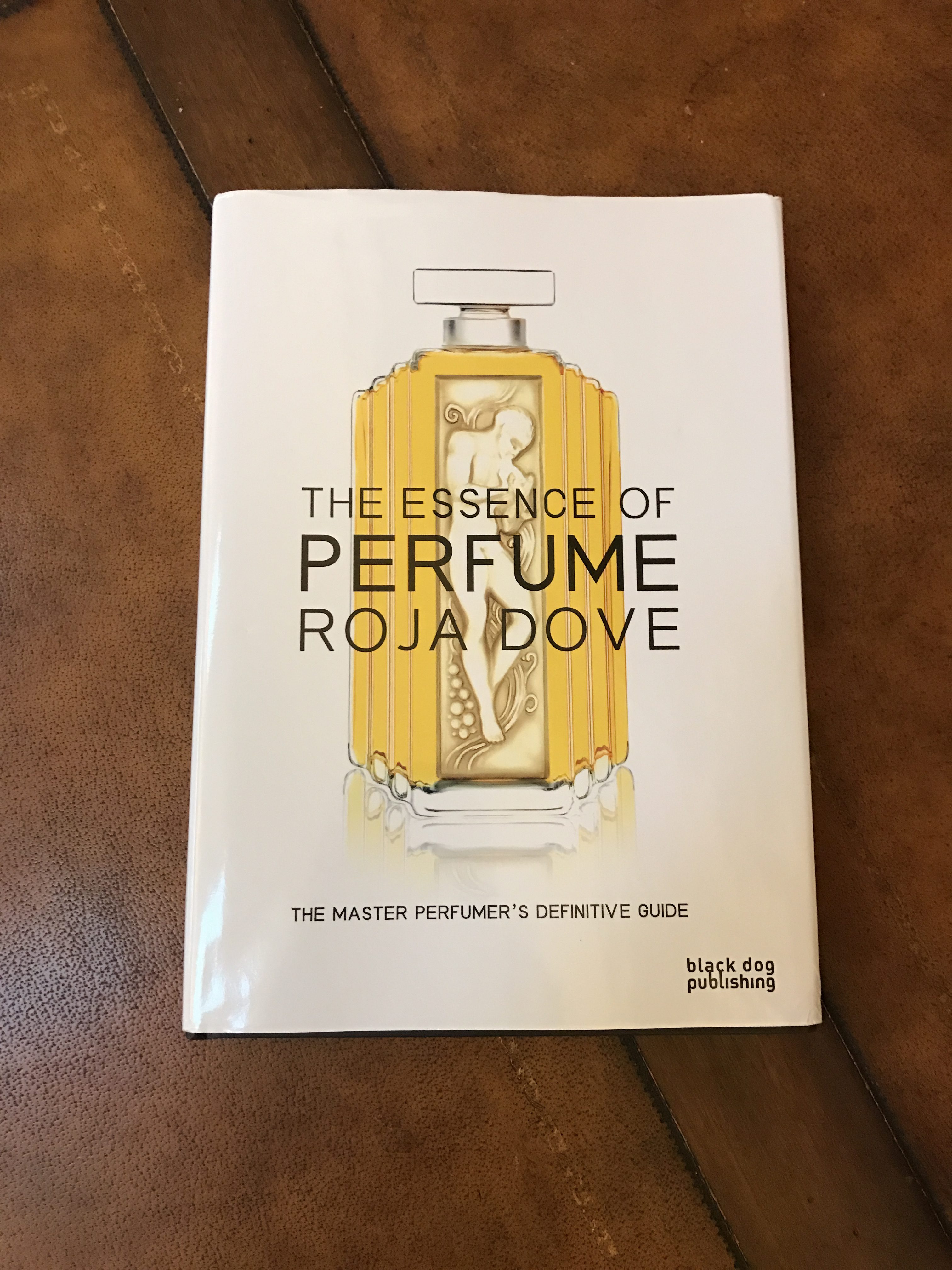
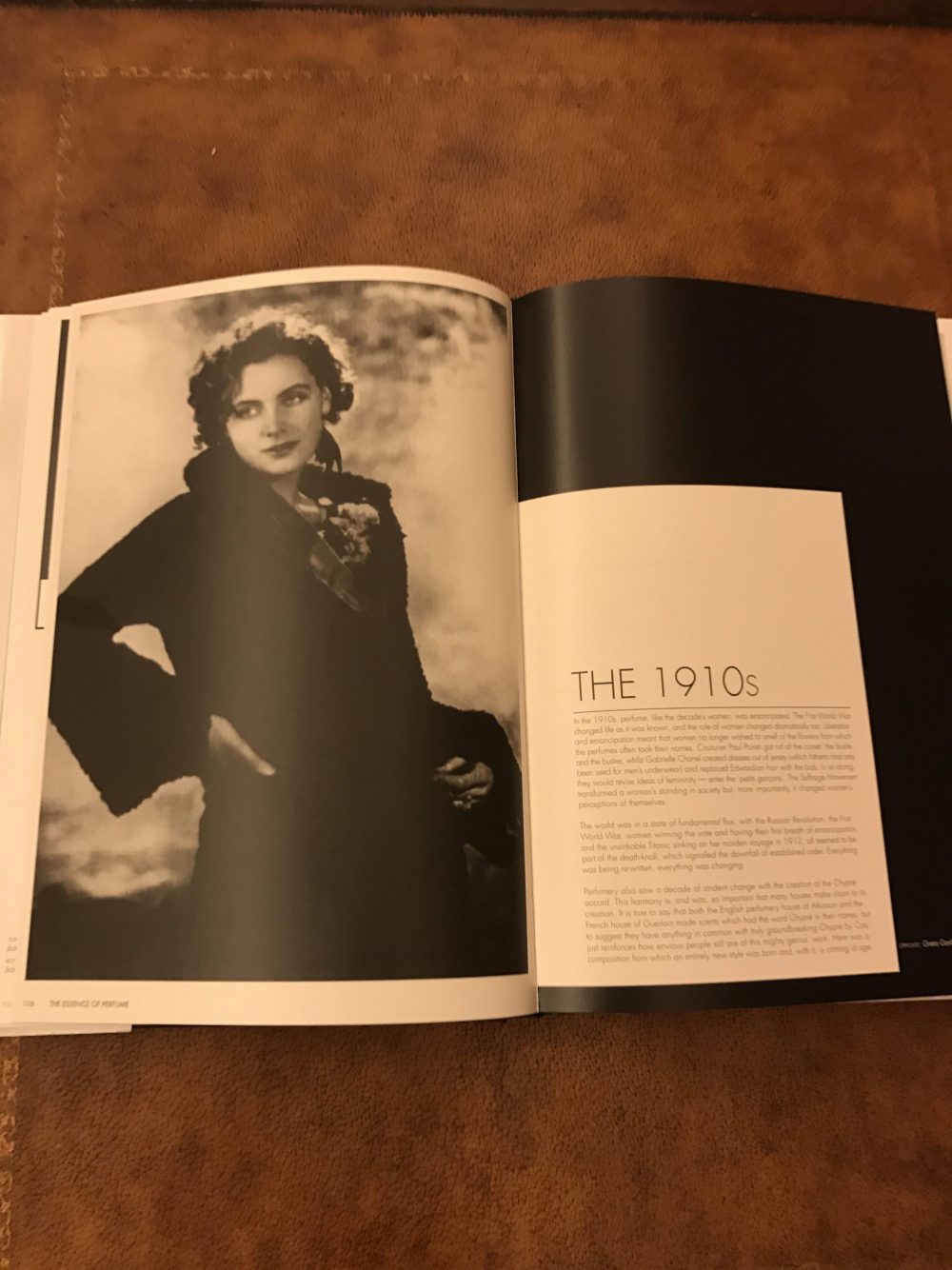
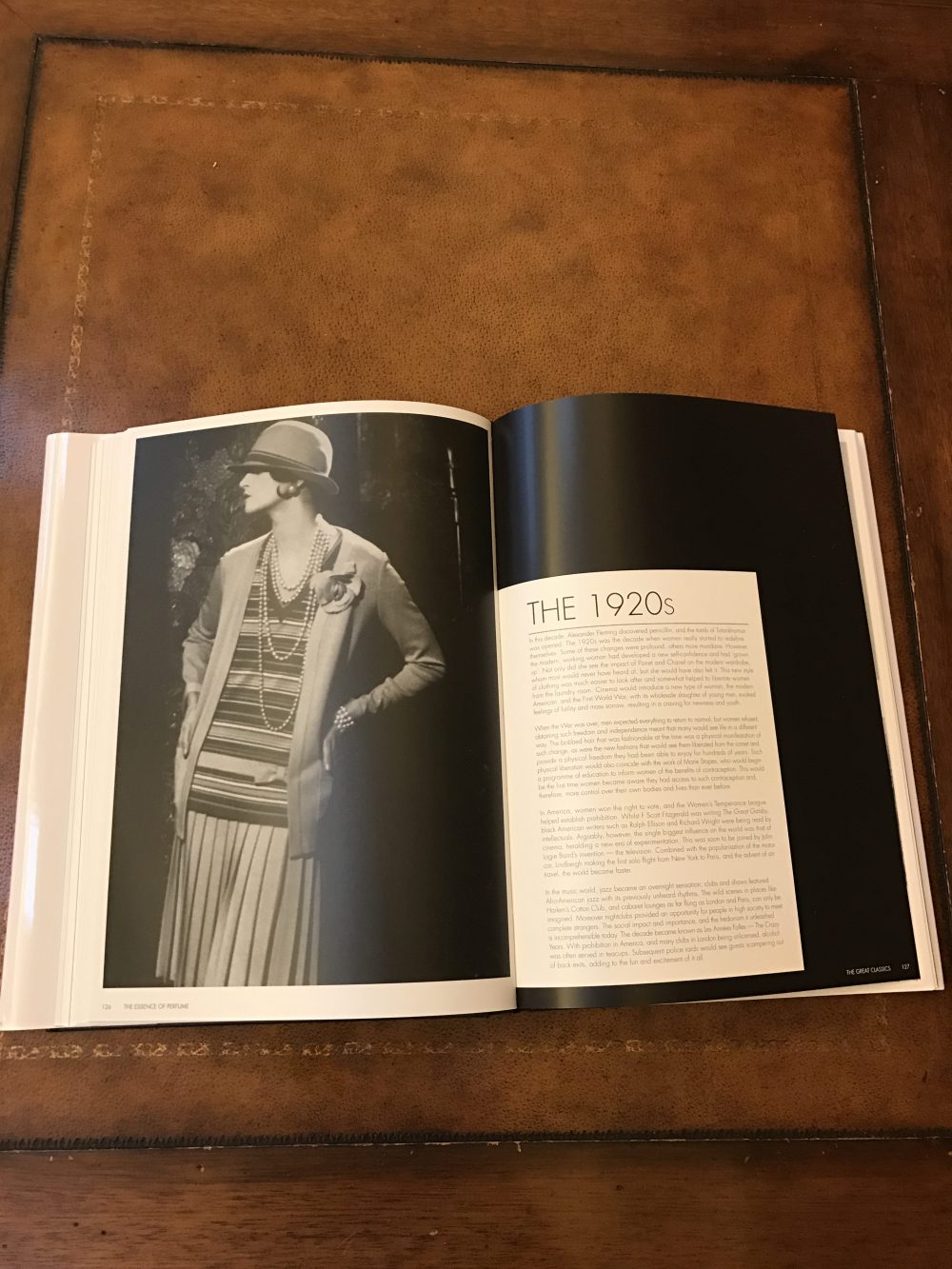
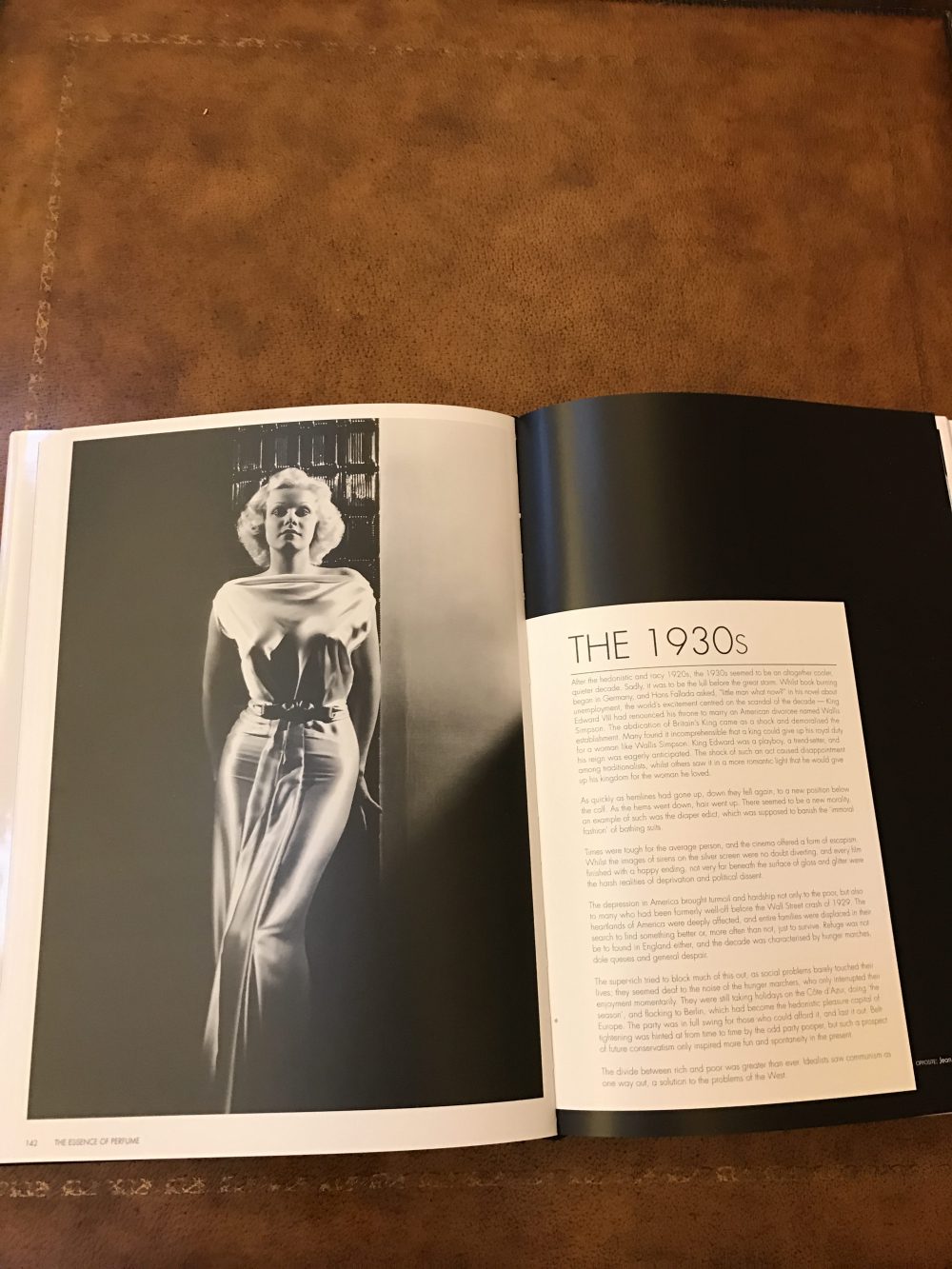
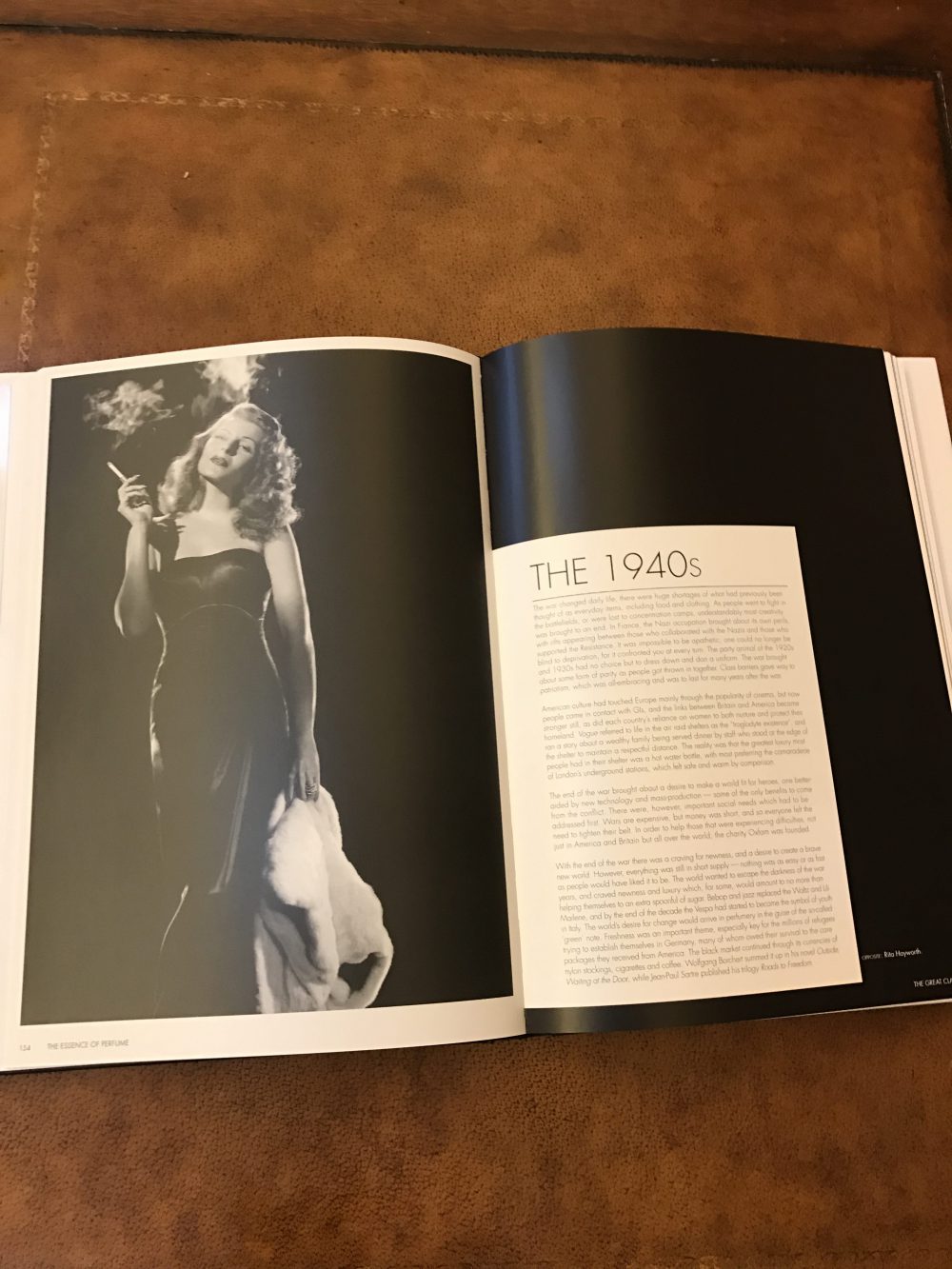
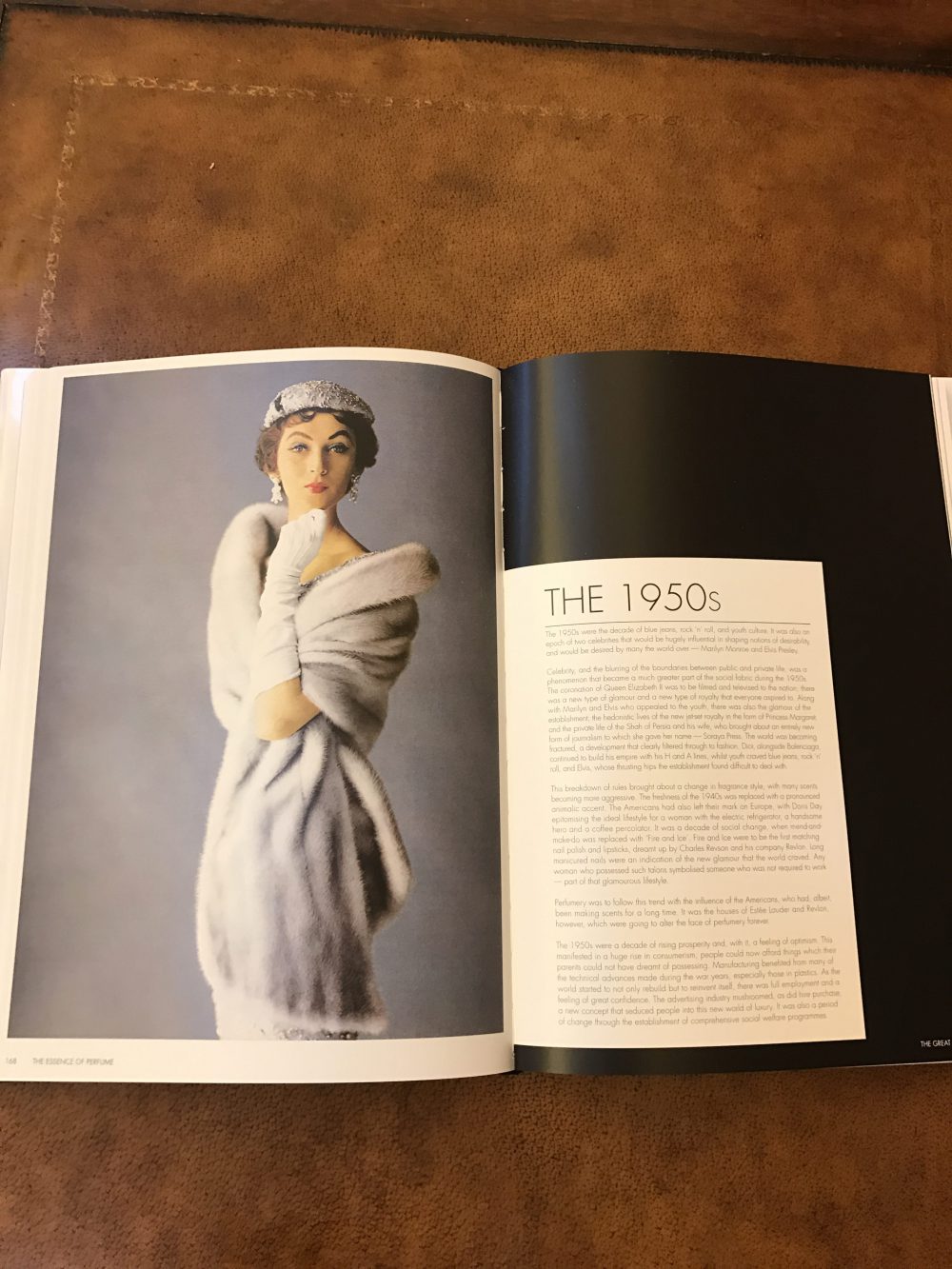

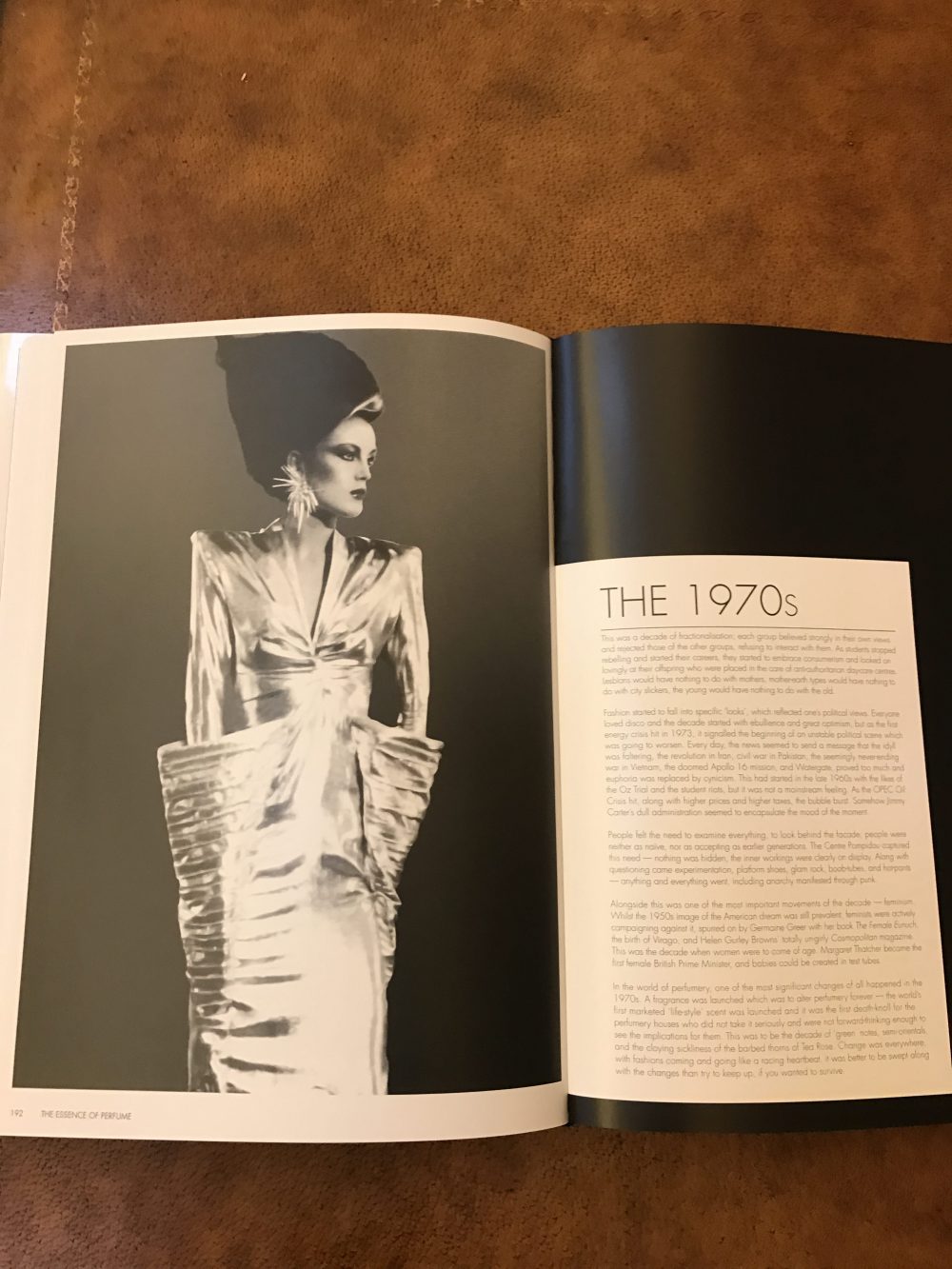
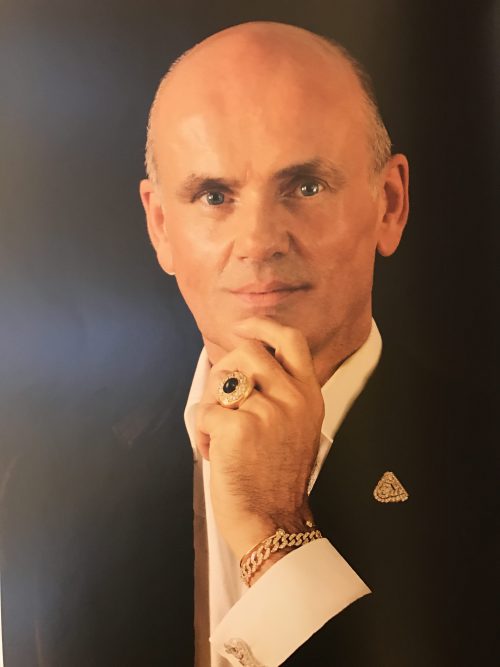

One of my daughter’s friends goes to an ivy league school and she is studying to become a scent aficionado. Sometimes you forget all of the amazing lines of work there are in this world. This would make an excellent gift for her. I’m glad I came across this. Thank you!!
Hi Jonelle,
I’ve heard about Christophe Laudamiel, a fine-fragrance perfumer at International Flavors and Fragrances(IFF), giving standing-room-only lectures at Harvard. Since perfume-making has been an industry that operates in secrecy, education and training has historically only been offered by institutions such as ISIPCA and The Grasse Institute of Perfumery in France. International Flavors & Fragrances in the USA also has an internal perfumery school but you must work for IFF in order to attend the school and it is very competitive to be admitted to one of the few spots each year.
The Essence of Perfume would be a perfect gift for your daughter’s friend. I’d be very surprised if she didn’t love it:)
Erica
Hi!
Your article on this perfume book was very well done. I loved reading about the history of perfume and I really had no idea some of those perfumes of the early 1900s still exist today. This is a great coffee table book to leave out and let guests browse through it. I love perfume ( what woman doesnt) and history itself so this is right up my alley! Thanks for a great read!
Hi Robin,
The history of perfume was my favorite part since I love history too but there are many other really great parts I didn’t have time to touch on, such as: the great fragrance houses, the structure of various scents and the bottle makers. There are also some truly gorgeous examples of vintage perfume bottles.
Thanks for stopping by!
Erica